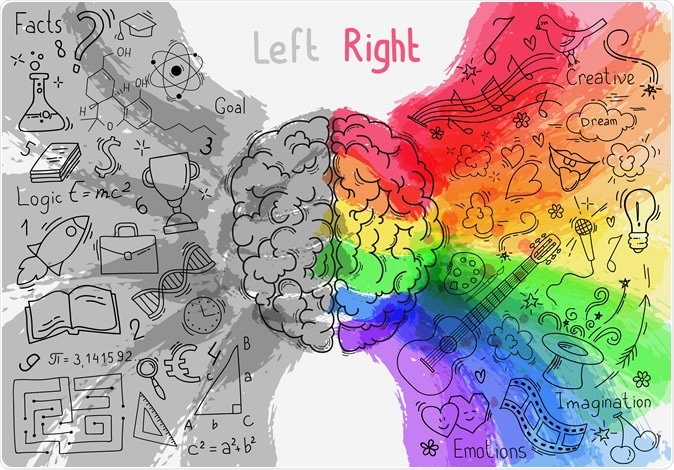A new study has discovered four genes related to left-handedness, and the associated differences in the way the brain is organized. About a tenth of people are left-handed, making this a not uncommon trait. However, the new findings point to greater verbal fluency with this alternate version of the brain, compared to right-handedness.
Of course, a genetic basis for handedness has long been known, at least in part due to studies in twins, the exact variants were not known. About 25% of this trait has been suggested to be due to genes, since identical twins were more likely to have the same hand than fraternal twins or siblings.

Concept of the human brain, left v right. Image Credit: Oksana Telesheva / Shutterstock
How was the study done?
Earlier studies seeking differences in brain topography between left- and right-handed people have been small in sample size, with the largest so far covering only about 100 subjects. This has failed to show any significant differences in the cortex as such, but increased activation of the language-associated areas in the right or both sides of the brain has been a consistent finding.
In the current study, the researchers examined the DNA sequencing data from 400,000 people, of whom about a tenth were left-handed. To do this, they drew on the UK Biobank database which contains DNA from volunteers. Using genome-wide association studies (GWAS), their search for single-nucleotide polymorphisms (SNPs), where the DNA strand is altered by just one ‘letter’, took them to four genetic loci that showed association with left-handedness, on chromosomes 2, 6, 17 and 22.
Three of these alterations were inside genes which determine the structure and development of the brain cells, as well as their eventual arrangement. In particular, they determine the way the cell skeleton is built by influencing microtubule arrays, including left-right asymmetry. For instance, a snail shell may coil to the left or to the right.
The researchers also looked at the brain scans from the same people whose DNA was studied showed that the genes that showed up more often in left-handed people were also found in those whose brains showed a difference in the white matter bundles, or ‘tracts’, that interlink language-associated areas of the brain.
What does the study show?
The findings from this study show that left-handedness is at least partly a genetically determined trait. The current study hints that the early brain develops in such a way under the influence of these genes as to promote the dominance of the right language areas and in creating better functional pathways, possibly by guiding the white matter axons and the formation of new neurons, between language areas on both sides.
As a result, inter-brain communication is apparently more coordinated in left-handed people, conferring more functional connectivity between language-related areas. This confirms earlier imaging studies that show that left-handers have better coordination in the way language generation and comprehension areas on both sides of the brain work together. The study also shows, like earlier research, that in left-handers language areas on the right side of the brain are more active than on the left.
Explaining this, researcher Gwenaëlle Douaud says that the natural brain waves are not only more synchronized but they continue even without overt voluntary brain activity, and this synchronization is seen in the language areas of the brain.
Another intriguing link was observed between the brain differences associated with handedness and neuropsychiatric attributes. For example, left-handedness is correlated with increased sensitivity, being highly-strung, neuroticism, the worrying trait, and feeling fed-up.
Older studies have shown a 45% increased risk of schizophrenia in left-handedness. The current study also found a positive association between left-handedness and schizophrenia. Conversely, Parkinson’s disease is less likely in this group. They postulate that this might be the result of the same underlying differences in the way the brain develops, and therefore genetic in origin. However, they emphasize that the association doesn’t mean that one causes the other, and the total number of cases will be small.
Researcher Akira Wiberg says, “This raises the intriguing possibility for future research that left-handers might have an advantage when it comes to performing verbal tasks, but it must be remembered that these differences were only seen as averages over very large numbers of people and not all left-handers will be similar.” More work is needed to test this hypothesis, focusing on verbal testing in multiple areas.
The study was published in the journal Brain on September 5, 2019.
Journal reference:
Handedness, language areas and neuropsychiatric diseases: insights from brain imaging and genetics. Akira Wiberg, Michael Ng, Yasser Al Omran, Fidel Alfaro-Almagro, Paul McCarthy, Jonathan Marchini, David L Bennett, Stephen Smith, Gwenaëlle Douaud, & Dominic Furniss. Brain, awz257. https://doi.org/10.1093/brain/awz257. https://academic.oup.com/brain/advance-article/doi/10.1093/brain/awz257/5556832